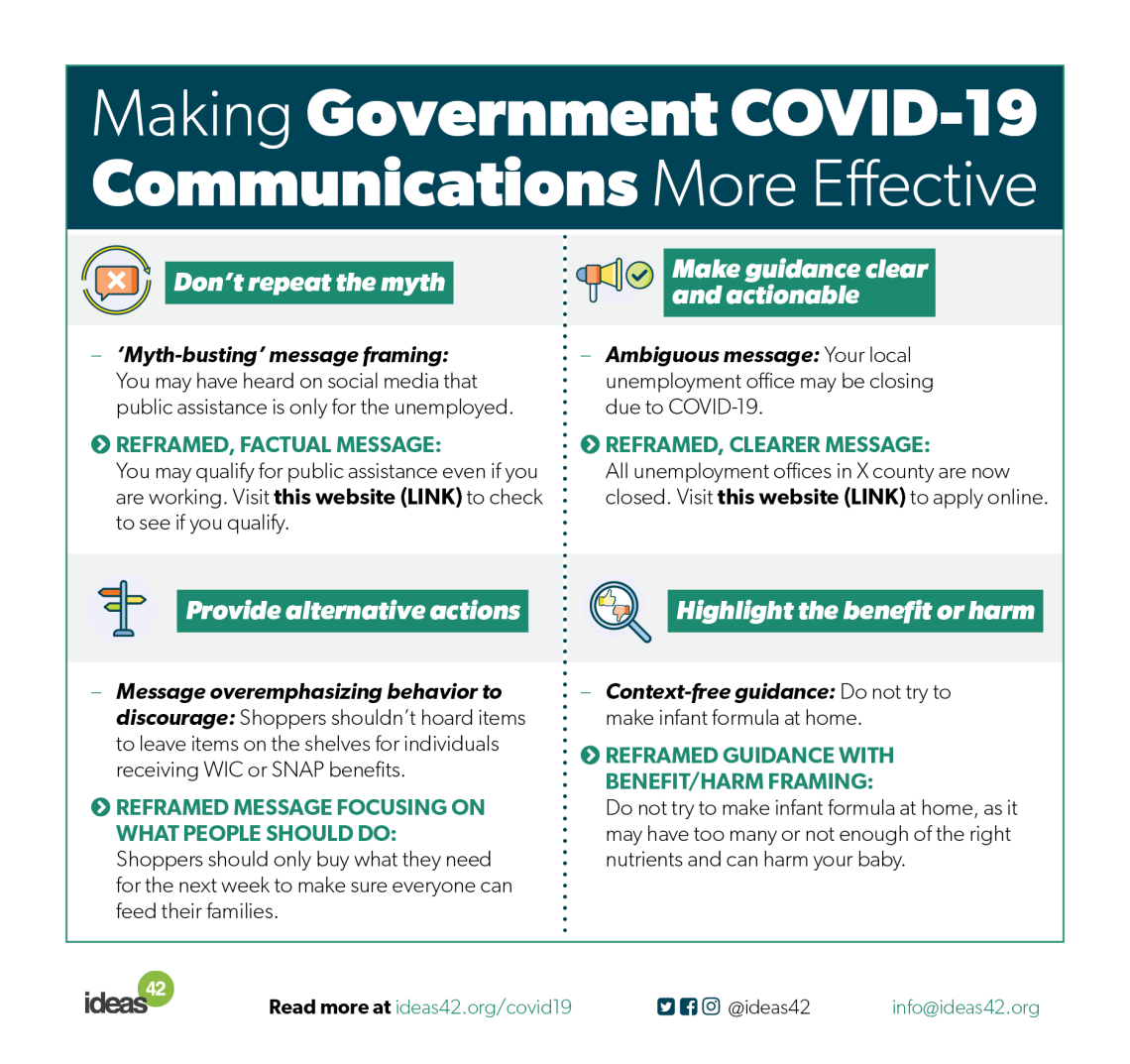This is part of a series of posts about behavioral science and COVID-19. Click here to read about some of the most important behaviors during this pandemic—like seeking medical help, responding to humanitarian crises, and adapting to remote work in a global outbreak.
Since the onset of the COVID-19 pandemic, many public benefits programs in the United States–such as the Supplemental Nutrition Assistance Program (SNAP), the Special Supplemental Nutrition Program for Women, Infants, and Children (WIC), and the Temporary Assistance for Needy Families (TANF)–have been working day and night to adjust to ongoing changes in their respective rules, eligibility requirements, or operating procedures. Adapting to such changes is critical to ensuring not only that their current clients keep benefitting from critical programs and services in a time of extreme hardship and uncertainty for the nation, but also that newly eligible people can enroll in and access such services.
Good messaging is key to keeping current and potential beneficiaries informed and updated, as well as ensuring the general public is informed. But what’s the best way for states to communicate these changes?
Since the crisis started, we’ve been working with state agencies to help make their communications on public benefits more effective. Below are four principles that we’ve applied in our work that could be useful for other governments and benefits agencies to keep in mind when designing effective messaging around COVID-19.
- Don’t repeat the myth
Due to the fluid nature of this crisis, there are a lot of myths circulating online about public benefits programs, and agencies may be tempted to address them in their messaging. However, putting out “myth buster” communications can backfire and actually perpetuate the myth. Evidence suggests that repeated falsehoods stick, even if we know they’re not true.
Instead of trying to repeat and debunk a myth, the main message in any communication should be the facts people should know. Additionally, consider reminding the reader to evaluate the credibility of information sources before sharing.
For example,
‘Myth-busting’ message framing: You may have heard on social media that public assistance is only for the unemployed.
Reframed, factual message: You may qualify for public assistance even if you are working. Visit this website (LINK) to check to see if you qualify.
- Make guidance clear and actionable
As new policies and procedures are released at a rapid pace, states will also need to communicate the changes to existing and prospective participants. Here, small psychological hurdles like complex wording or ambiguous next steps can make it hard for the audience to understand the guidance provided, or what actions they should take. This will reduce the likelihood that they follow through on the action required.
Instead, make sure that your message is short, clear and easy to read (for example, by omitting unnecessary details and avoiding jargon). If readers are being asked to do something, make sure the next steps are obvious, and make them easy to follow (for example, by providing a prominent link to the website, phone number, or an actionable checklist).
For example,
Ambiguous message: Your local unemployment office may be closing due to COVID-19.
Reframed, clearer message: All unemployment offices in X county are now closed. Visit this website (LINK) to apply online.
- Provide alternative actions
Often, communications will involve asking your audience to refrain from taking an action, like panic buying groceries in the face of the COVID-19 pandemic.
In these cases, it may be useful to reframe the message to focus on the behavior you’re seeking to promote, rather on what you’re trying to discourage. This saves your audience the cognitive effort of trying to think of alternatives, and also alleviates the uncertainty of whether alternatives are allowed.
For example,
Message overemphasizing behavior to discourage: Shoppers shouldn’t hoard items to leave items on the shelves for individuals receiving WIC or SNAP benefits.
Reframed message focusing on what people should do: Shoppers should only buy what they need for the next week to make sure everyone can feed their families.
- Highlight the benefit or harm
In responding to the pandemic, state agencies are also tasked with providing guidance to a variety of audiences beyond their usual scope. In recent weeks, states have issued guidance on a wide range of topics, from best practices for staying healthy and safe, to shopping tips.
Messages of this nature should explain the benefits or consequences of the action as this has been shown to lead to behavior change.
For example,
Context-free guidance: Do not try to make infant formula at home.
Reframed guidance with benefit/harm framing: Do not try to make infant formula at home, as it may have too many or not enough of the right nutrients and can harm your baby.
States are facing a very difficult task of communicating complicated program changes during this public health crisis, and making simple tweaks like the above can have an outsized impact on agencies’ ability to serve those who benefit from their programs. These principles are just a starting point–behavioral science has much more to offer for practitioners; for more evidence-based ideas for simplifying and improving official communications, check out this checklist.
Are you working with a public agency and need more guidance on your communications during the COVID-19 pandemic? Reach out to us and let’s talk: allison@ideas42.org.




